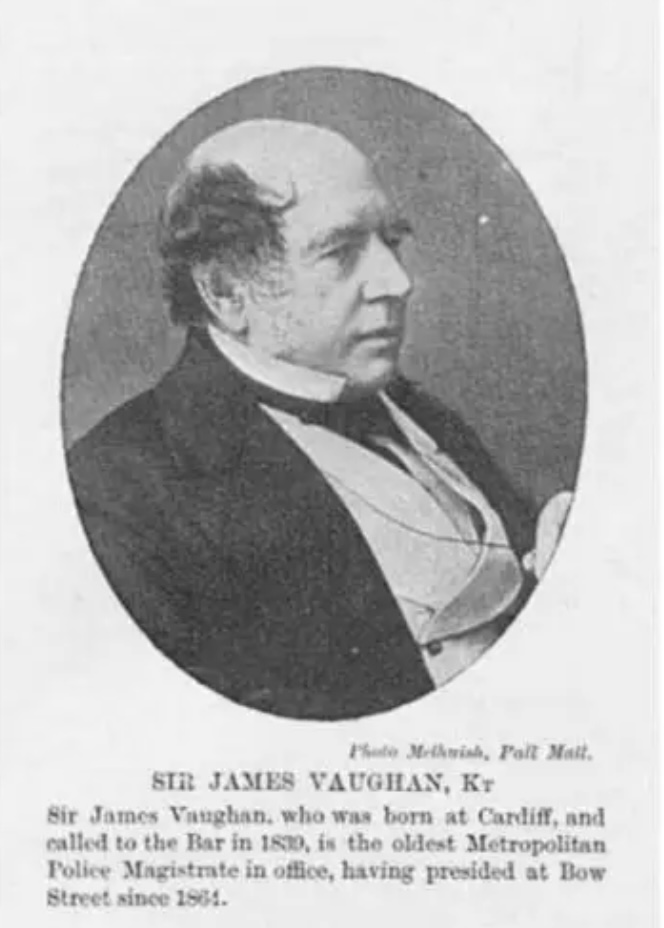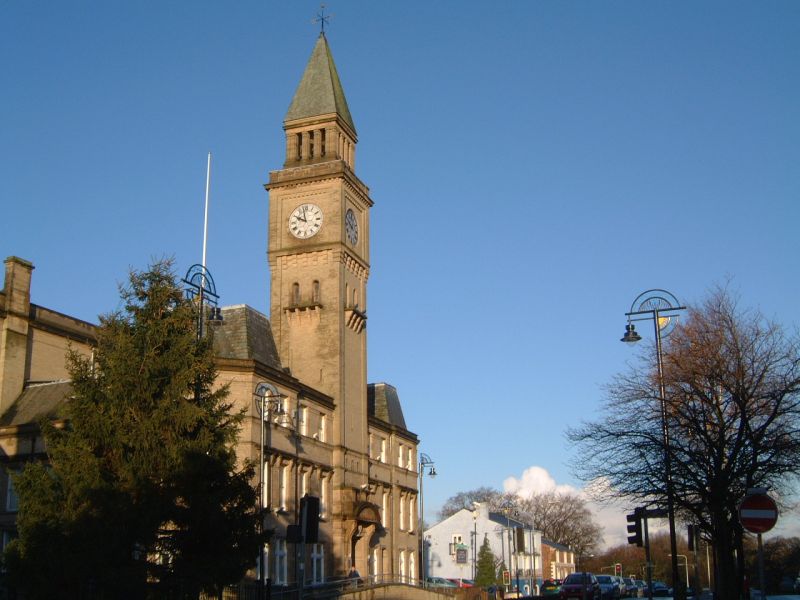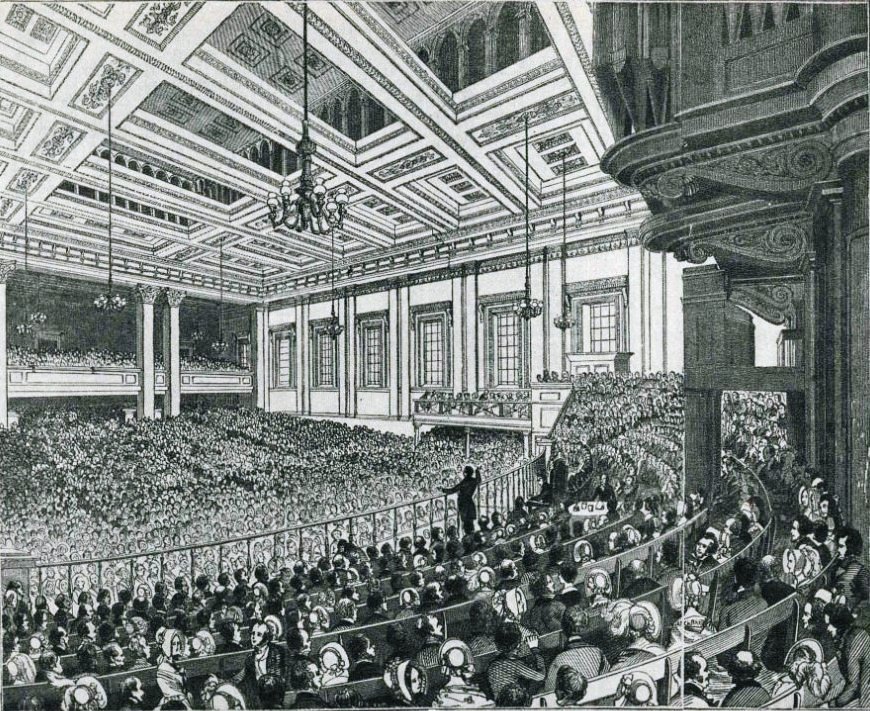|
James Vaughan (magistrate)
Sir James Vaughan (1814–20 May 1906) was a long-serving stipendiary magistrate at Bow Street Magistrates' Court in London from 1864 to 1899. In 1897 he was knighted by Queen Victoria for services to the Law.Award of Knighthood to James Vaughan '' The Edinburgh Gazette'', 13 August 1897, p. 789Award of Knighthood to James Vaughan '' The London Gazette'', Publication date:10 August 1897, Issue:26881, Page:4481 Si ... [...More Info...] [...Related Items...] OR: [Wikipedia] [Google] [Baidu] |
James Vaughan, Vanity Fair, 1890-10-25
James is a common English language surname and given name: *James (name), the typically masculine first name James * James (surname), various people with the last name James James or James City may also refer to: People * King James (other), various kings named James * Saint James (other) * James (musician) * James, brother of Jesus Places Canada * James Bay, a large body of water * James, Ontario United Kingdom * James College, a college of the University of York United States * James, Georgia, an unincorporated community * James, Iowa, an unincorporated community * James City, North Carolina * James City County, Virginia ** James City (Virginia Company) ** James City Shire * James City, Pennsylvania * St. James City, Florida Arts, entertainment, and media * ''James'' (2005 film), a Bollywood film * ''James'' (2008 film), an Irish short film * ''James'' (2022 film), an Indian Kannada-language film * James the Red Engine, a character in ''Thomas the Tank Eng ... [...More Info...] [...Related Items...] OR: [Wikipedia] [Google] [Baidu] |
The Sketch
''The Sketch'' was a British illustrated weekly journal. It ran for 2,989 issues between 1 February 1893 and 17 June 1959. It was published by the Illustrated London News Company and was primarily a society magazine with regular features on royalty, aristocracy and high society, as well as theatre, cinema and the arts. It had a high photographic content with many studies of society ladies and their children as well as regular layouts of point to point racing meetings and similar events. Clement Shorter and William Ingram started ''The Sketch'' in 1893. Shorter was the first editor, from 1893 to 1900, succeeded by John Latey (until his death in 1902) and then Keble Howard.Philip Waller, ''Writers, Readers, and Reputations: Literary Life in Britain 1870–1918'', pp. 351–2 Bruce Ingram was editor from 1905 to 1946. The magazine is remembered for first publishing the illustrations of Bonzo the dog by George E. Studdy (from 1921). It featured series of short stories wit ... [...More Info...] [...Related Items...] OR: [Wikipedia] [Google] [Baidu] |
Vanity Fair (British Magazine)
''Vanity Fair'' was a British weekly magazine that was published from 1868 to 1914. Founded by Thomas Gibson Bowles in London, the magazine included articles on fashion, theatre, current events as well as word games and serial fiction. The cream of the period’s "society magazines", it is best known for its witty prose and caricatures of famous people of Victorian and Edwardian society, including artists, athletes, royalty, statesmen, scientists, authors, actors, business people and scholars. Taking its title from Thackeray's popular satire on early 19th-century British society, ''Vanity Fair'' was not immediately successful and struggled with competition from rival publications. Bowles then promised his readers 'Some Pictorial Wares of an entirely novel character', and on 30 January 1869, a full-page caricature of Benjamin Disraeli appeared. This was the first of over 2,300 caricatures to be published. According to the National Portrait Gallery in London, "''Vanity Fairs il ... [...More Info...] [...Related Items...] OR: [Wikipedia] [Google] [Baidu] |
Leslie Ward
Sir Leslie Matthew Ward (21 November 1851 – 15 May 1922) was a British portrait artist and caricaturist who over four decades painted 1,325 portraits which were regularly published by '' Vanity Fair'', under the pseudonyms "Spy" and "Drawl". The portraits were produced as watercolours and turned into chromolithographs for publication in the magazine. These were then usually reproduced on better paper and sold as prints. Such was his influence in the genre that all ''Vanity Fair'' caricatures are sometimes referred to as "Spy cartoons" regardless of who the artist actually was. Early portraits, almost always full-length (judges at the bench being the main exception), had a stronger element of caricature and usually distorted the proportions of the body, with a very large head and upper body supported on much smaller lower parts. Later, as he became more accepted by his social peers, and in order not to offend potential sitters, his style developed into what he called "chara ... [...More Info...] [...Related Items...] OR: [Wikipedia] [Google] [Baidu] |
Caricature
A caricature is a rendered image showing the features of its subject in a simplified or exaggerated way through sketching, pencil strokes, or other artistic drawings (compare to: cartoon). Caricatures can be either insulting or complimentary, and can serve a political purpose, be drawn solely for entertainment, or for a combination of both. Caricatures of politicians are commonly used in editorial cartoons, while caricatures of movie stars are often found in entertainment magazines. In literature, a ''caricature'' is a distorted representation of a person in a way that exaggerates some characteristics and oversimplifies others. Etymology The term is derived for the Italian ''caricare''—to charge or load. An early definition occurs in the English doctor Thomas Browne's ''Christian Morals'', published posthumously in 1716. with the footnote: Thus, the word "caricature" essentially means a "loaded portrait". Until the mid 19th century, it was commonly and mistakenly beli ... [...More Info...] [...Related Items...] OR: [Wikipedia] [Google] [Baidu] |
Cleveland Street Scandal
The Cleveland Street scandal occurred in 1889, when a homosexual male brothel and house of assignation on Cleveland Street, London, was discovered by police. The government was accused of covering up the scandal to protect the names of aristocratic and other prominent patrons. At the time, sexual acts between men were illegal in Britain, and the brothel's clients faced possible prosecution and certain social ostracism if discovered. It was rumoured that Prince Albert Victor, the eldest son of the Prince of Wales and second-in-line to the British throne, had visited, though this has never been substantiated. Unlike overseas newspapers, the British press never named Albert Victor, but the allegation influenced the handling of the case by the authorities and has coloured biographers' perceptions of him since. The police acquired testimonies that Lord Arthur Somerset, an equerry to the Prince of Wales, was a patron. Both he and the brothel keeper, Charles Hammond, managed to flee ... [...More Info...] [...Related Items...] OR: [Wikipedia] [Google] [Baidu] |
Henry James FitzRoy, Earl Of Euston
Henry James FitzRoy, Earl of Euston (28 November 1848 – 10 May 1912) was the eldest son and heir apparent of Augustus FitzRoy, 7th Duke of Grafton. His mother was the daughter of MP James Balfour. Personal life Euston married a music hall artiste "Kate Cooke", real name Kate Walsh, daughter of John Walsh, on 29 May 1871 at St. Michael's Church, Worcester. Described as "one of the most notorious women in London" she was at least ten years his senior.''Letter of Marquise De Fontenoy'', Chicago Tribune, 9 August 1904, http://archives.chicagotribune.com/1903/05/18/page/12/article/letter-of-marquise-de-fontenoy/index.html They had no children, and separated after three years, Euston securing a government position in Australia. Having discovered that Walsh had contracted a bigamous marriage, he returned to London to seek an annulment. At great expense Walsh's presumed husband was located in New Zealand and brought to London. In a case that was termed "stranger than fiction", at the ... [...More Info...] [...Related Items...] OR: [Wikipedia] [Google] [Baidu] |
Libel
Defamation is the act of communicating to a third party false statements about a person, place or thing that results in damage to its reputation. It can be spoken (slander) or written (libel). It constitutes a tort or a crime. The legal definition of defamation and related acts as well as the ways they are dealt with can vary greatly between countries and jurisdictions (what exactly they must consist of, whether they constitute crimes or not, to what extent proving the alleged facts is a valid defence). Defamation laws can encompass a variety of acts: * Insult against a legal person in general * Defamation against a legal person in general * Acts against public officials * Acts against state institutions (e.g., government, ministries, government agencies, armed forces) * Acts against state symbols * Acts against the state itself * Acts against religions (e.g., blasphemy, discrimination) * Acts against the judiciary or legislature (e.g., contempt of court, censure) ... [...More Info...] [...Related Items...] OR: [Wikipedia] [Google] [Baidu] |
Ernest Parke
Ernest is a given name derived from Germanic word ''ernst'', meaning "serious". Notable people and fictional characters with the name include: People *Archduke Ernest of Austria (1553–1595), son of Maximilian II, Holy Roman Emperor *Ernest, Margrave of Austria (1027–1075) *Ernest, Duke of Bavaria (1373–1438) *Ernest, Duke of Opava (c. 1415–1464) *Ernest, Margrave of Baden-Durlach (1482–1553) *Ernest, Landgrave of Hesse-Rheinfels (1623–1693) *Ernest Augustus, Elector of Brunswick-Lüneburg (1629–1698) *Ernest, Count of Stolberg-Ilsenburg (1650–1710) *Ernest Augustus, King of Hanover (1771–1851), son of King George III of Great Britain *Ernest II, Duke of Saxe-Coburg and Gotha (1818–1893), sovereign duke of the Duchy of Saxe-Coburg and Gotha *Ernest Augustus, Crown Prince of Hanover (1845–1923) *Ernest, Landgrave of Hesse-Philippsthal (1846–1925) *Ernest Augustus, Prince of Hanover (1914–1987) *Prince Ernst August of Hanover (born 1954) Prince Ernst ... [...More Info...] [...Related Items...] OR: [Wikipedia] [Google] [Baidu] |
Chorley
Chorley is a town and the administrative centre of the wider Borough of Chorley in Lancashire, England, north of Wigan, south west of Blackburn, north west of Bolton, south of Preston and north west of Manchester. The town's wealth came principally from the cotton industry. In the 1970s, the skyline was dominated by factory chimneys, but most have now been demolished: remnants of the industrial past include Morrisons chimney and other mill buildings, and the streets of terraced houses for mill workers. Chorley is the home of the Chorley cake. History Toponymy The name ''Chorley'' comes from two Anglo-Saxon words, and , probably meaning "the peasants' clearing". (also or ) is a common element of place-name, meaning a clearing in a woodland; refers to a person of status similar to a freeman or a yeoman. Prehistory There was no known occupation in Chorley until the Middle Ages, though archaeological evidence has shown that the area around the town has been inhabit ... [...More Info...] [...Related Items...] OR: [Wikipedia] [Google] [Baidu] |
Kensal Green Cemetery
Kensal Green Cemetery is a cemetery in the Kensal Green area of Queens Park in the Royal Borough of Kensington and Chelsea in London, England. Inspired by Père Lachaise Cemetery in Paris, it was founded by the barrister George Frederick Carden.The Founding of Kensal Green Cemetery Accessed 7 February 2014 The cemetery opened in 1833 and comprises of grounds, including two conservation areas, adjoining a canal. The cemetery is home to at least 33 species of bird and other wildlife. This distinctive cemetery has memorials ranging from large mausoleums housing the rich and famous to many distinctive smaller graves and includes special areas dedicated to the very young. It has three chapels and serves all faiths. It ... [...More Info...] [...Related Items...] OR: [Wikipedia] [Google] [Baidu] |
John Bright
John Bright (16 November 1811 – 27 March 1889) was a British Radical and Liberal statesman, one of the greatest orators of his generation and a promoter of free trade policies. A Quaker, Bright is most famous for battling the Corn Laws. In partnership with Richard Cobden, he founded the Anti-Corn Law League, aimed at abolishing the Corn Laws, which raised food prices and protected landowners' interests by levying taxes on imported wheat. The Corn Laws were repealed in 1846. Bright also worked with Cobden in another free trade initiative, the Cobden–Chevalier Treaty of 1860, promoting closer interdependence between Great Britain and the Second French Empire. This campaign was conducted in collaboration with French economist Michel Chevalier, and succeeded despite Parliament's endemic mistrust of the French. Bright sat in the House of Commons from 1843 to 1889, promoting free trade, electoral reform and religious freedom. He was almost a lone voice in opposing the ... [...More Info...] [...Related Items...] OR: [Wikipedia] [Google] [Baidu] |






